
- Media library
- Question limits
- Creating a survey from MS Word doc
- How to edit live surveys
- Survey blocks
- Survey block randomizer
- Question randomization
- Scale Library
- What is monadic testing?
- What is sequential monadic testing?
- Extraction Support for Image Chooser Question Types
- What is comparison testing?
- Custom validation messages
- Survey Builder with QuestionPro AI
- Testing Send
- Survey Preview Options
- Add Questions From a Document
- Survey Authoring 2025
- Standard question types
- Multiple choice question type
- Text question- comment box
- Matrix multi-point scales question type
- Rank order question
- Smiley-rating question
- Image question type
- Date and time question type
- reCAPTCHA question type
- Net Promoter Score question type
- Van Westendorp's price sensitivity question
- Choice modelling questions
- Side-By-Side matrix question
- Homunculus question type
- Predictive answer options
- Presentation text questions
- Multiple choice: select one
- Multiple choice: select many
- Page timer
- Contact information question
- Matrix multi-select question
- Matrix spreadsheet question
- Closed card sorting question
- Flex Matrix
- Text Slider Question Type
- Graphical Rating Scales
- Rank Order - Drag and Drop
- Bipolar Matrix - Slider
- Bipolar Matrix Likert Scale
- Gabor Granger
- Verified Digital Signature
- Star Rating Question Type
- Push to social
- Attach Upload File Question
- Constant Sum Question
- Video Insights
- Platform connect
- Communities Recruitment
- TubePulse
- Open Card Sorting
- Map Question Type
- LiveCast
- Answer type
- Reorder questions
- Question tips
- Text box next to question
- Text question settings
- Adding other option
- Matrix question settings
- Image rating question settings
- Scale options for numeric slider question
- Constant sum question settings
- Setting default answer option
- Exclusive option for multiple choice questions
- Validate question
- Bulk validation settings
- Remove validation message
- Question separators
- Question Code
- Page breaks in survey
- Survey introduction with acceptance checkbox
- RegEx Validation
- Question Library
- Embed Media
- Slider Start Position
- Answer Display - Alternate Flip
- Matrix - Auto Focus Mode
- Text validations
- Numeric Input Settings- Spreadsheet
- Answer Groups
- Hidden Questions
- Decimal Separator Currency Format
- Allow Multiple Files - Attache/Upload Question Type
- Text box - Keyboard input type
- Deep Dive
- Answer Display Order
- Alternate colors
- Conjoint Best Practices
- Multi-media file limits
- Conjoint Prohibited Pairs
- Add logo to survey
- Custom Themes
- Display Settings
- Auto-advance
- Progress bar
- Automatic question numbering option
- Enabling social network toolbar
- Browser Title
- Print or export to PDF, DOC
- Survey Navigation Buttons
- Accessible Theme
- Back and Exit Navigation Buttons
- Focus Mode
- Survey Layout
- Survey Layout - Visual
- Telly Integration
- Telly Integration
- Workspace URL
- Classic Layout
- Branching - Skip Logic
- Compound Branching
- Compound or delayed branching
- Response Based Quota Control
- Dynamic text or comment boxes
- Extraction logic
- Show or hide question logic
- Dynamic show or hide
- Scoring logic
- Net promoter scoring model
- Piping text
- Survey chaining
- Looping logic
- Branching to terminate survey
- Logic operators
- Selected N of M logic
- JavaScript Logic Syntax Reference
- Block Flow
- Block Looping
- Scoring Engine: Syntax Reference
- Always Extract and Never Extract Logic
- Matrix Extraction
- Locked Extraction
- Dynamic Custom Variable Update
- Advanced Randomization
- Custom Scripting Examples
- Survey Logic Builder - AI
- Custom Scripting - Custom Logic Engine Question
- Survey settings
- Save & continue
- Anti Ballot Box Stuffing (ABBS) - disable multiple responses
- Deactivate survey
- Admin confirmation email
- Action alerts
- Survey timeout
- Finish options
- Spotlight report
- Print survey response
- Search and replace
- Survey Timer
- Allowing multiple respondents from the same device
- Text Input Size Settings
- Admin Confirmation Emails
- Survey Close Date
- Respondent Location Data
- Review Mode
- Review, Edit and Print Responses
- Geo coding
- Dynamic Progress Bar
- Response Quota
- Age Verification
- Tools - Survey Options
- Live survey URL
- Customize survey URL
- Create email invitation
- Personalizing emails
- Email invitation settings
- Email list filter
- Survey reminders
- Export batch
- Email status
- Spam index
- Send surveys via SMS
- Phone & paper
- Adding responses manually
- SMS Pricing
- Embedding Question In Email
- Deleting Email Lists
- Multilingual Survey Distribution
- SMTP
- Reply-To Email Address
- Domain Authentication
- Email Delivery Troubleshooting
- QR Code
- Email Delivery and Deliverability
- Survey Dashboard - Report
- Overall participant statistics
- Dropout analysis
- Pivot table
- Turf analysis
- Trend analysis
- Correlation analysis
- Survey comparison
- Gap analysis
- Mean calculation
- Weighted mean
- Spider chart
- Cluster Analysis
- Dashboard filter
- Download Options - Dashboard
- HotSpot analysis
- Heatmap analysis
- Weighted Rank Order
- Cross-Tabulation Grouping Answer Options
- A/B Testing in QuestionPro Surveys
- Data Quality
- Data Quality Terminates
- Matrix Heatmap Chart
- Column proportions test
- Response Identifier
- TURF Reach Analysis
- Bulk Edit System Variables
- Weighting and balancing
- Conjoint analysis designs
- Conjoint part worths calculation
- Conjoint calculations and methodology
- Conjoint attribute importance
- Conjoint profiles
- Market segmentation simulator
- Conjoint brand premium and price elasticity
- What is MaxDiff scaling
- MaxDiff settings
- Anchored MaxDiff Analysis [BETA Release]
- MaxDiff FAQ
- MaxDiff- Interpreting Results
- Automatic email report
- Data quality - Patterned responses
- Data quality - gibberish words
- Import external data
- Download center
- Consolidate report
- Delete survey data
- Data quality - All checkboxes selected
- Exporting data to Word or Powerpoint
- Scheduled reports
- Datapad
- Notification Group
- Unselected Checkbox Representation
- Merge Data 2.0
- Plagiarism Detection
- IP based location data
- SPSS Export
- SPSS variable name
- Update user details
- Update time zone
- Teams
- Add Users
- Usage dashboard
- Single user license
- License restrictions
- Troubleshooting login issues
- Software support package
- Welcome Email
- User Roles & Permissions
- Bulk Add Users
- Two-Factor Authentication
- Network Access
- Changing ownership of the survey
- Unable to access Chat support
- Navigating QuestionPro Products
- Agency Partnership Referral Program
- Response Limits
TURF Analysis
TURF analysis, an acronym for "total unduplicated reach and frequency", is a type of statistical analysis model used for providing estimates of media or market potential and devising optimal communication and placement strategies given limited resources. TURF analysis identifies the number of users reached by a communication, and how often they are reached.
TURF is a statistical model that can be used to answer questions like,- Where should we place ads to reach the widest possible audience?
- What kind of market-share will we gain if we add a new line to our model?
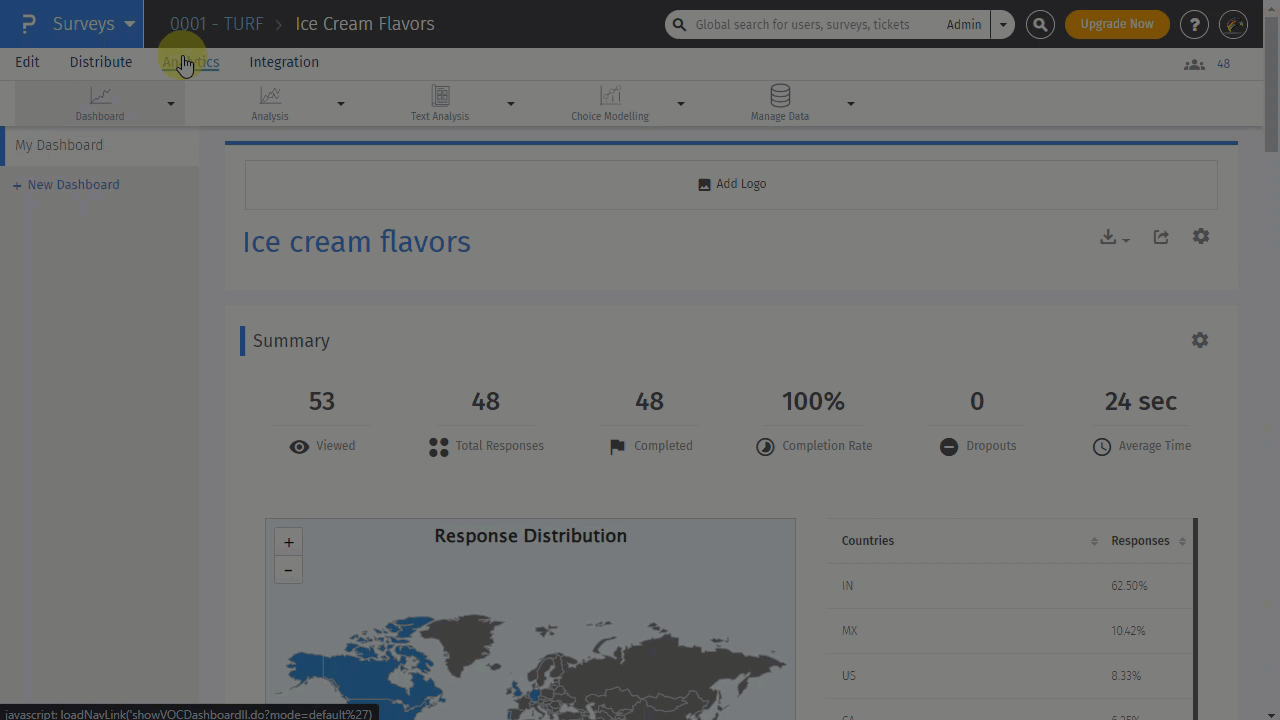 Click to download video
Click to download video
Let's consider an example of an ice cream shop launching flavors of ice cream. With QuestionPro we can collect feedback asking people about the ice cream flavors they like. Once data is collected, we can find answers to questions like:
- What will be the market share if certain ice cream flavours are launced
- Where should we promote these flavors to maximize reach
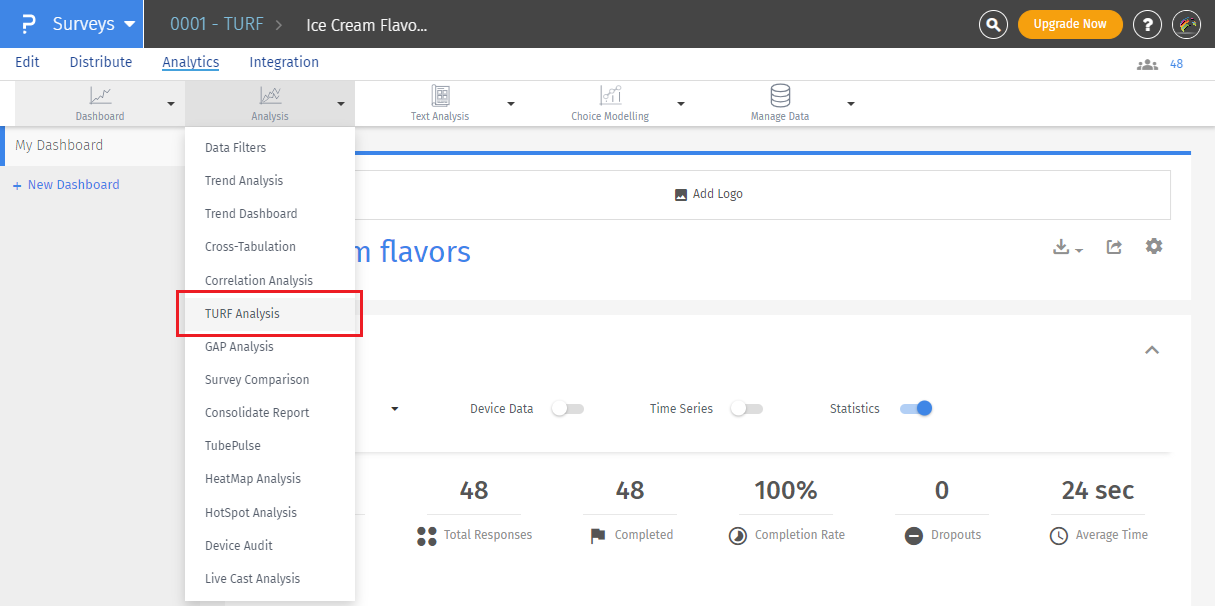 Select the question to analyze. Only supported questions will be available here.
Select the question to analyze. Only supported questions will be available here.

Top/Down reach shows you how many potential clients you would reach if you focused on any one particular item.
In this example, with the chocolate flavor, you would reach 56.25% of the total population. Please note that this is based on the number of people surveyed. You will need to be sure that your sample size is large enough to be able to make inferences about the total population you are studying.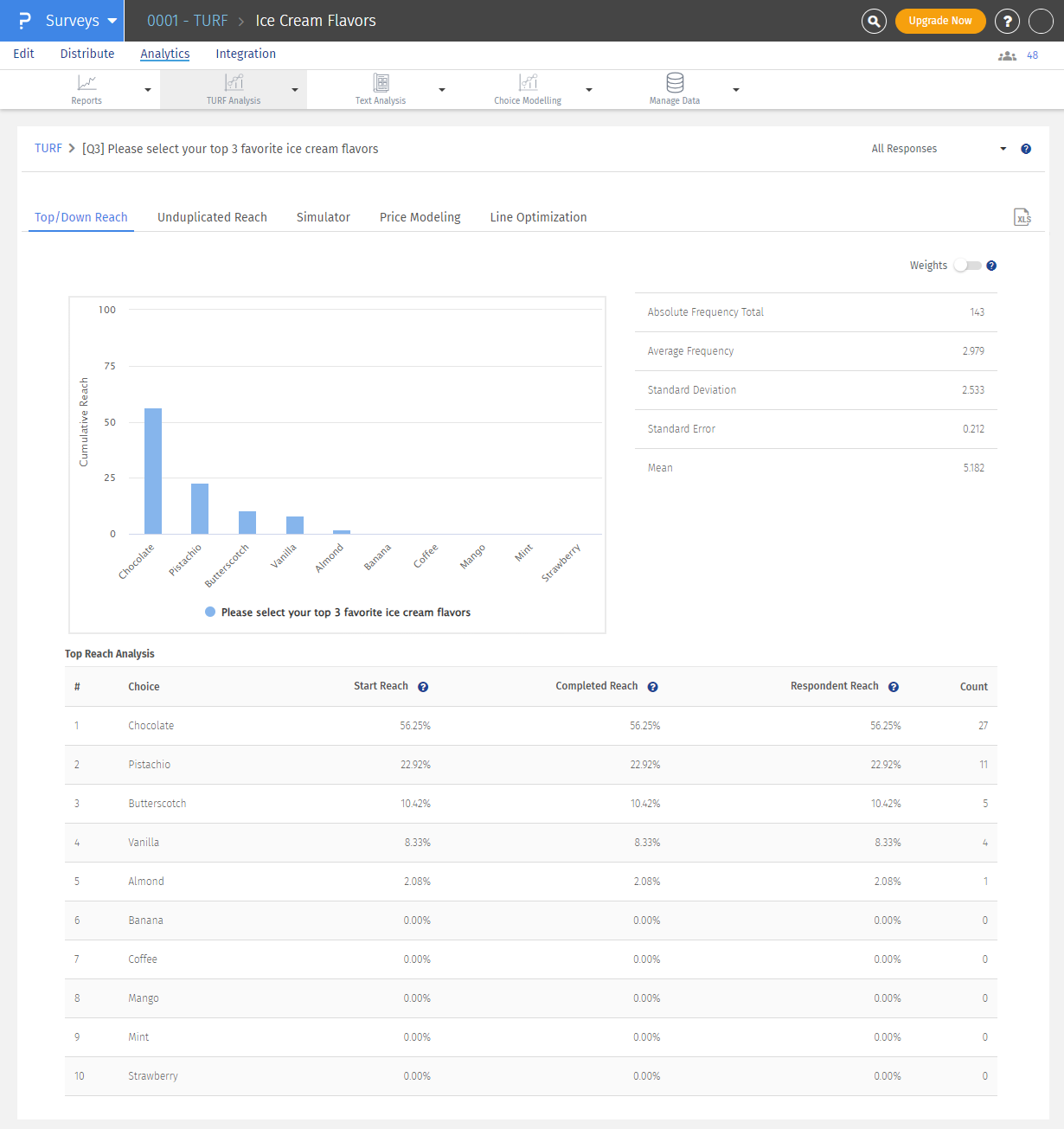
Unduplicated reach lets you mix and match up options to determine what kind of reach you would have if you focused on those particular combinations. To use this, check the boxes next to the options you want to include in the calculation.
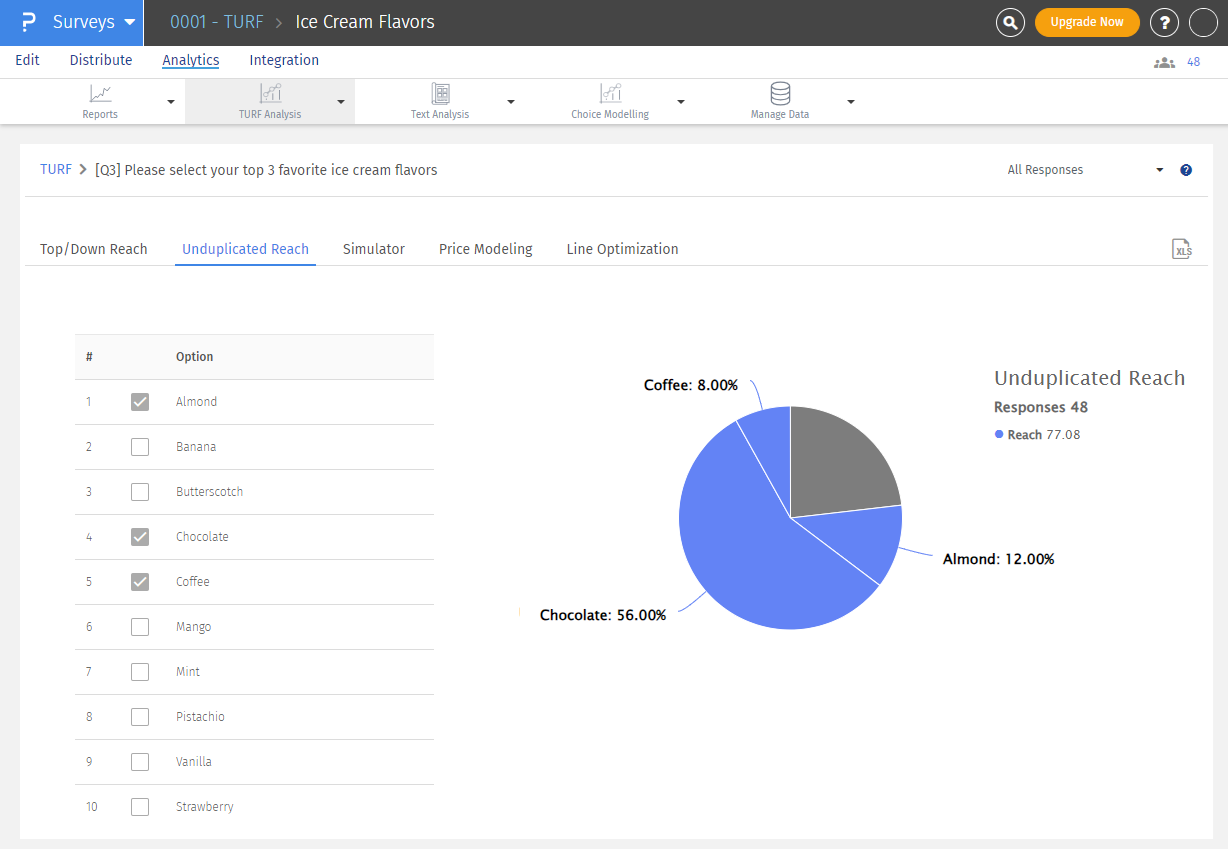
The simulator lets you choose how many items you want to focus on, then simulates the reach, cost, and count (based on the number of responses to your survey) for every combination of choices possible.
In this example, respondents had 10 choices. We ran an analysis on every combination of up to three choices to determine the best possible mix of items to focus on for the maximum reach. Select the simulation count and click Run Simulation.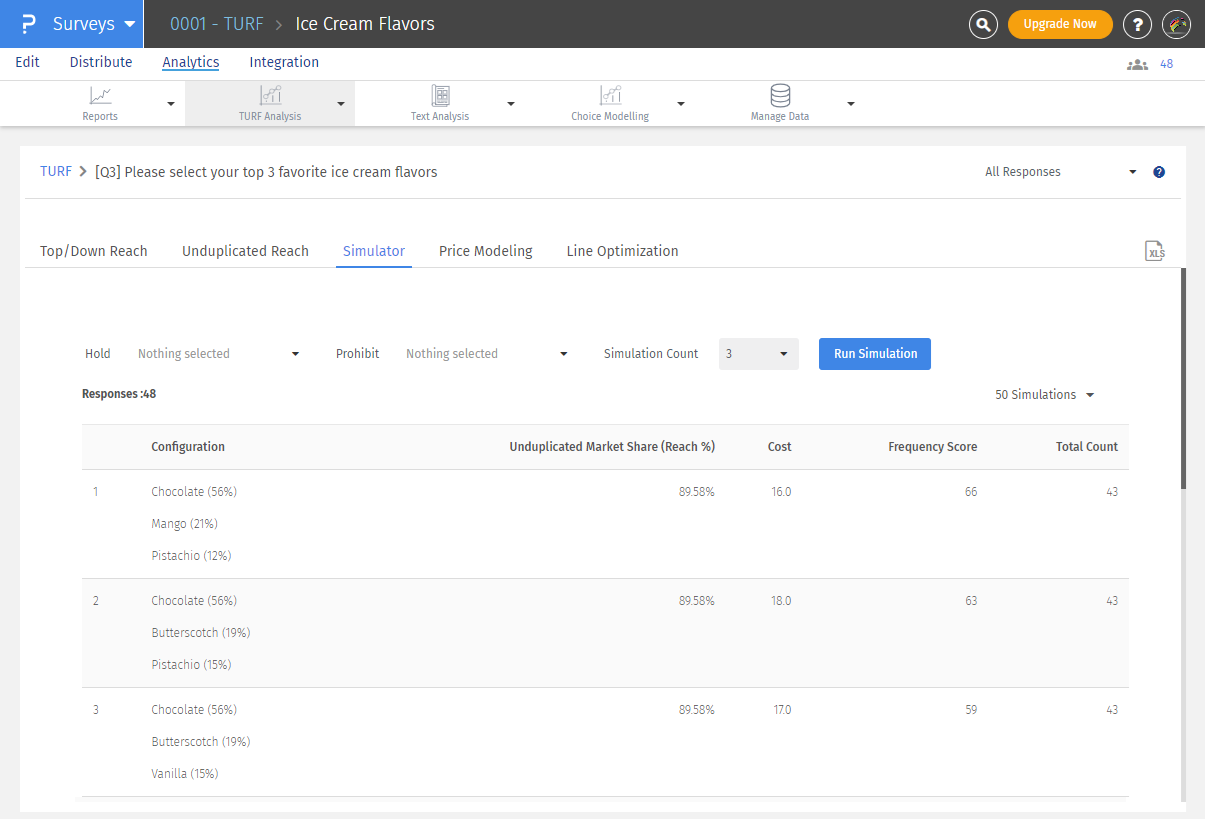 When running simulator, you can hold or prohibit certain options and run simulation.
Hold: Options selected under hold will be set as constant and TURF will be implemented across available options.
When running simulator, you can hold or prohibit certain options and run simulation.
Hold: Options selected under hold will be set as constant and TURF will be implemented across available options.
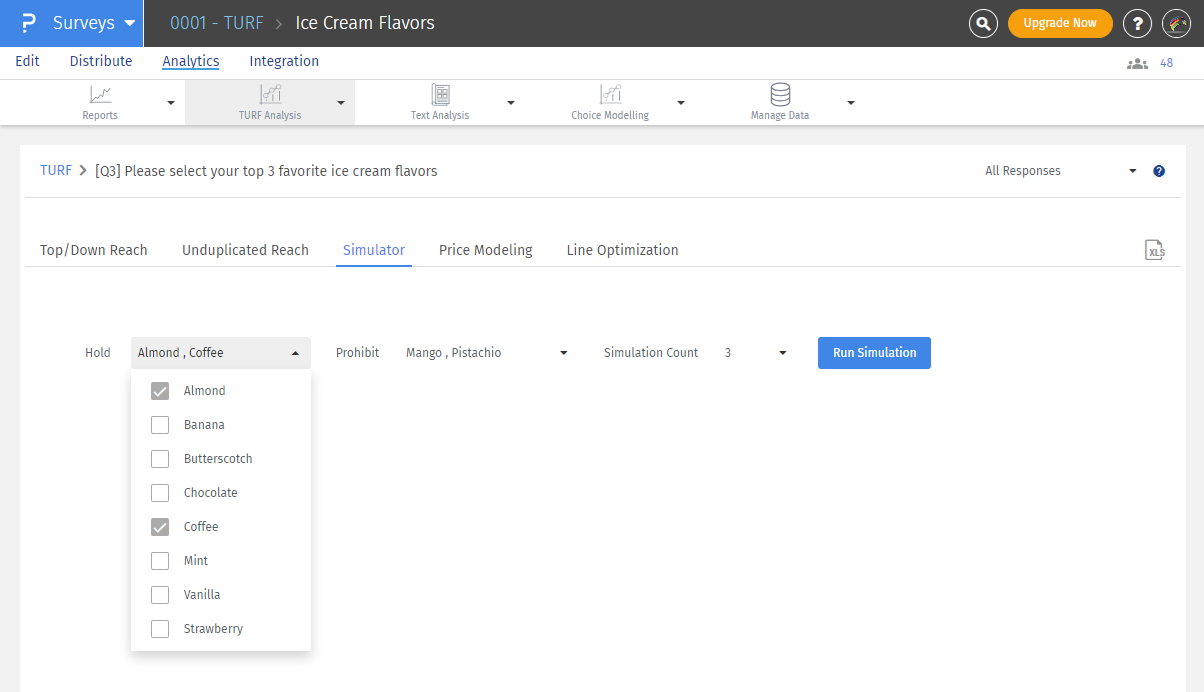 Prohibit: Options selected under prohibit will not be included in the simulation.
Prohibit: Options selected under prohibit will not be included in the simulation.
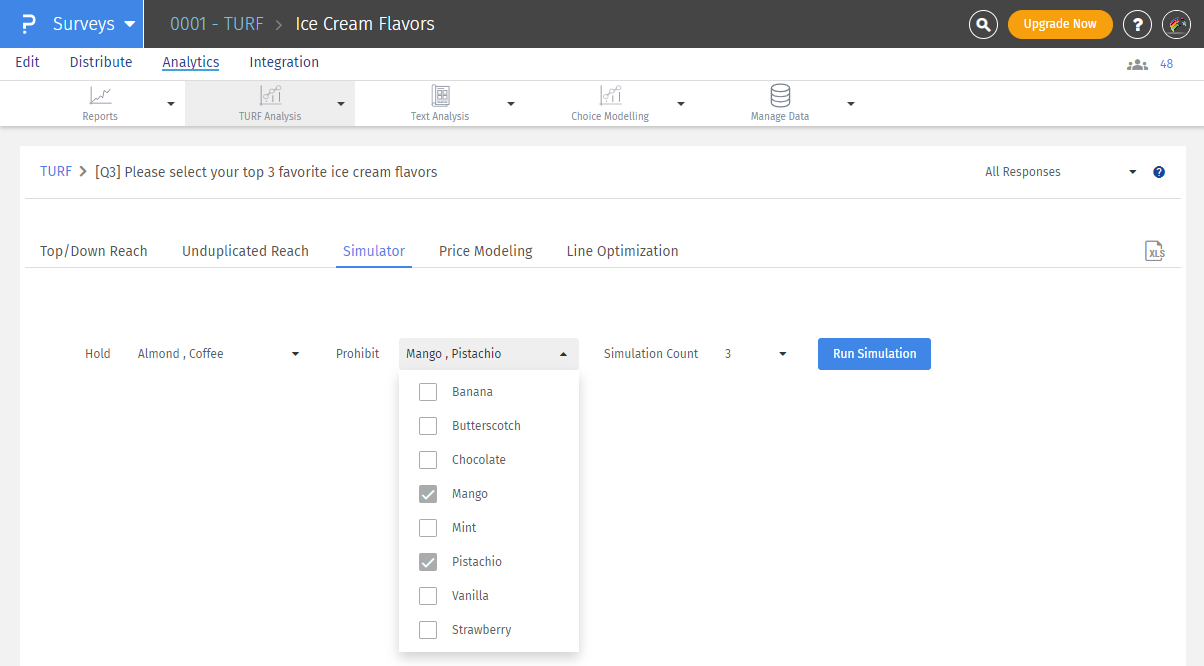
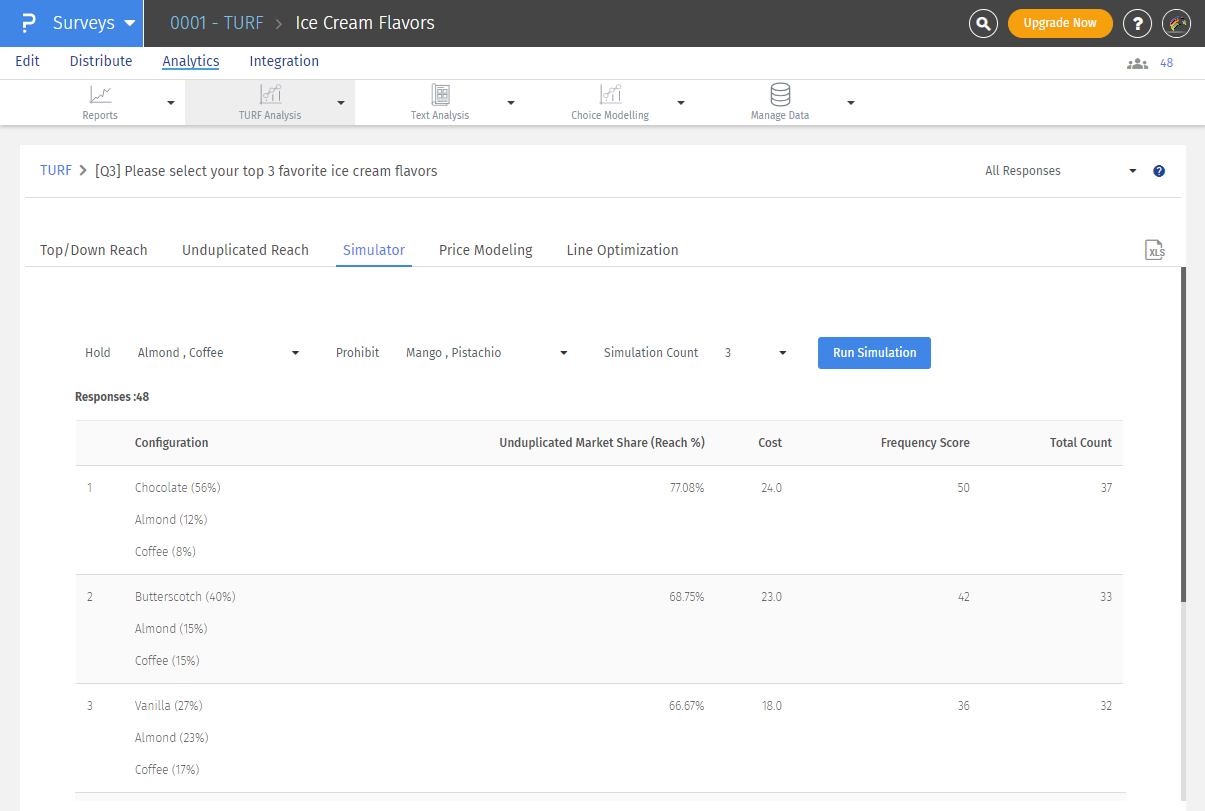 We have the following limits for running simulations online. If the number of options exceed for the simulation count, only the maximum options allowed will be picked based on their unduplicated reach and other options with lower reach will be prohibited automatically.
We have the following limits for running simulations online. If the number of options exceed for the simulation count, only the maximum options allowed will be picked based on their unduplicated reach and other options with lower reach will be prohibited automatically.
| Simulation count | Maximum numer of options |
|---|---|
| 2 Simulations | 49 Options |
| 3 Simulations | 20 Options |
| 4 Simulations | 14 Options |
| 5 Simulations or over | 12 Options |
Price modeling is just as it sounds. You enter the budget you are willing to spend overall and the tolerance you have (wiggle room) within that budget. For our example, we said we had a budget of 2,500 USD and a tolerance of 10%. You can also assign weights rather than prices. Click Simulate Price Modeling to calculate the every possible option group based on the budget desired, starting with the lowest budget threshold (budget – % tolerance) and working up to the highest budget amount. Note: If you go back to the simulator, you will find that the option sets here are now calculated with pricing.
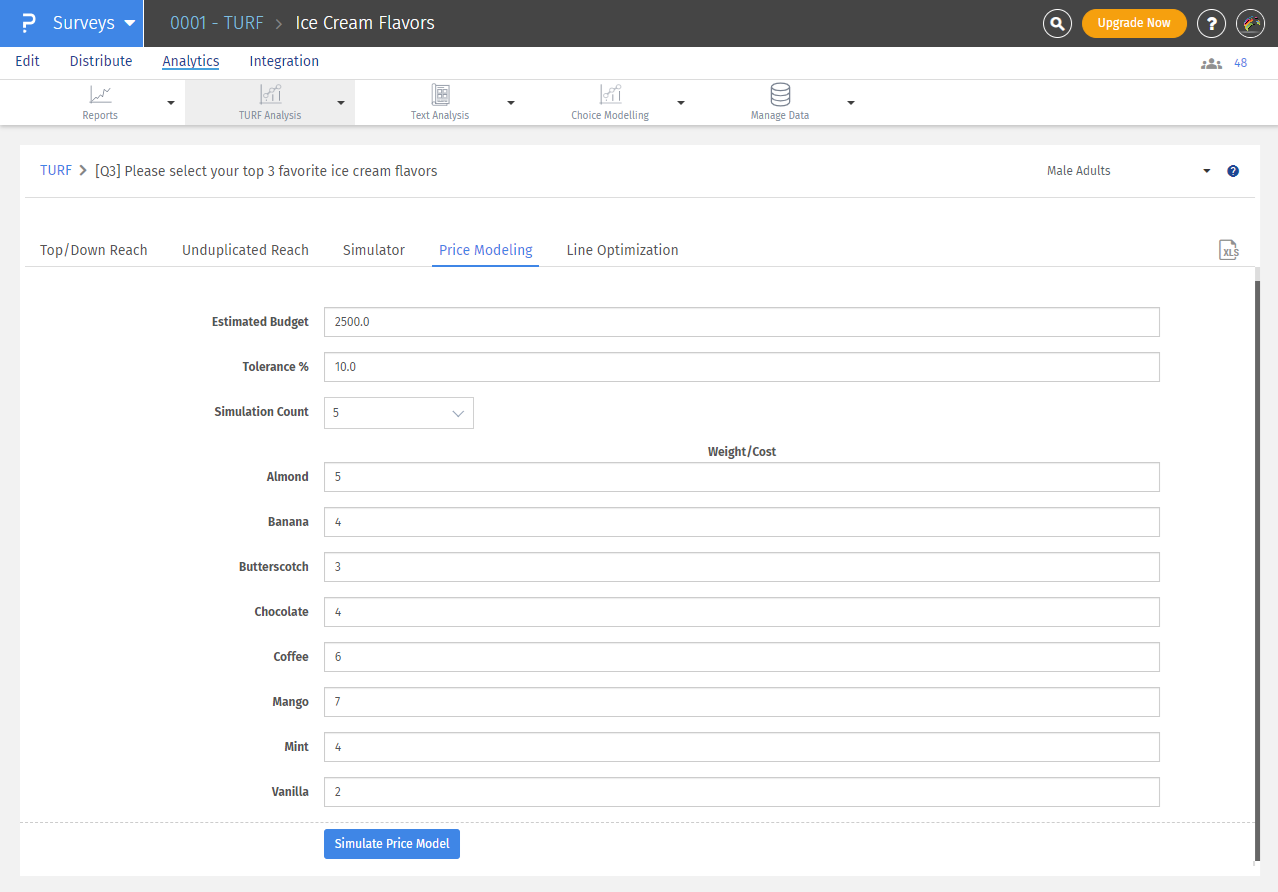
Line Optimization calculates the group of items that will meet your minimum reach desired at the lowest cost. To use this, simply input your minimum reach desired, adjust pricing if desired (if prices were assigned in Price Modeling, they will carry over to this tab), and click Simulate Line Optimization.
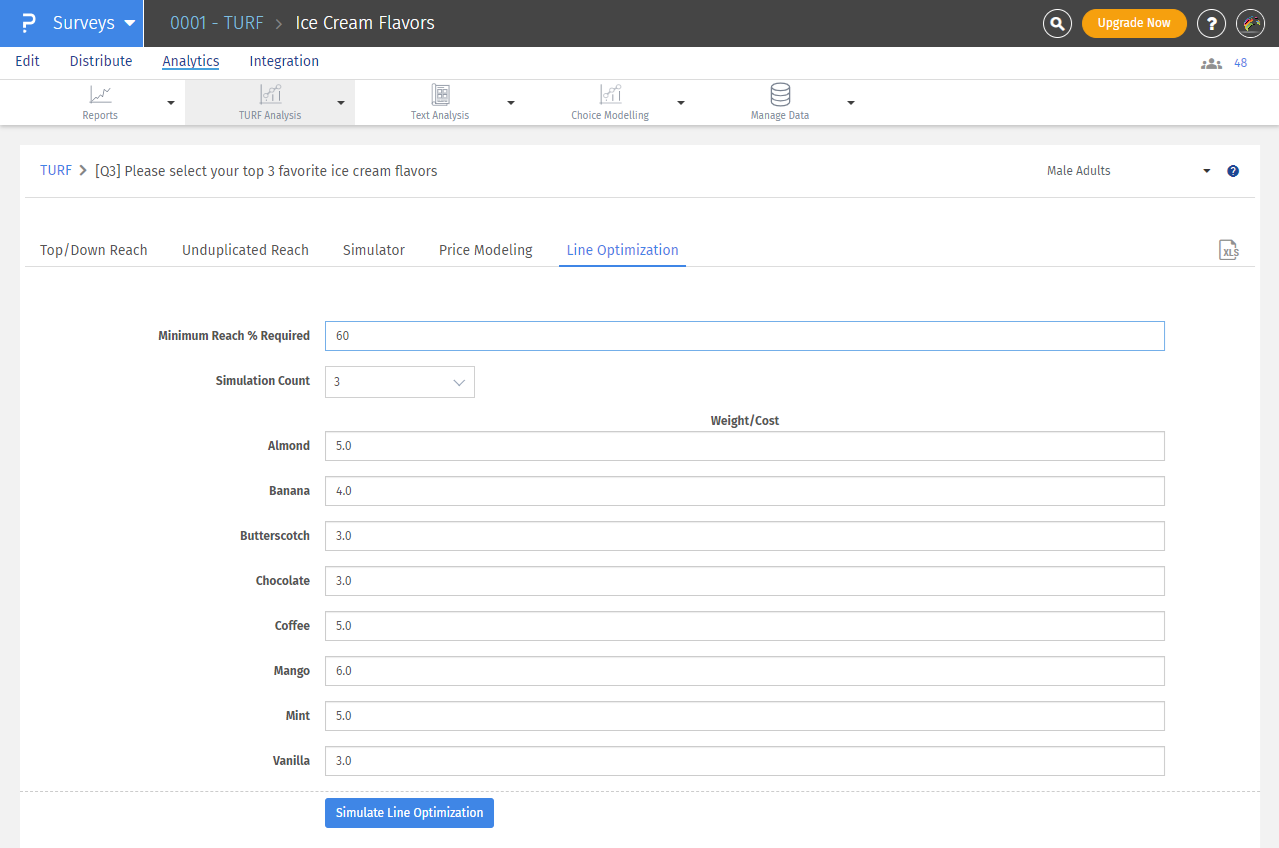
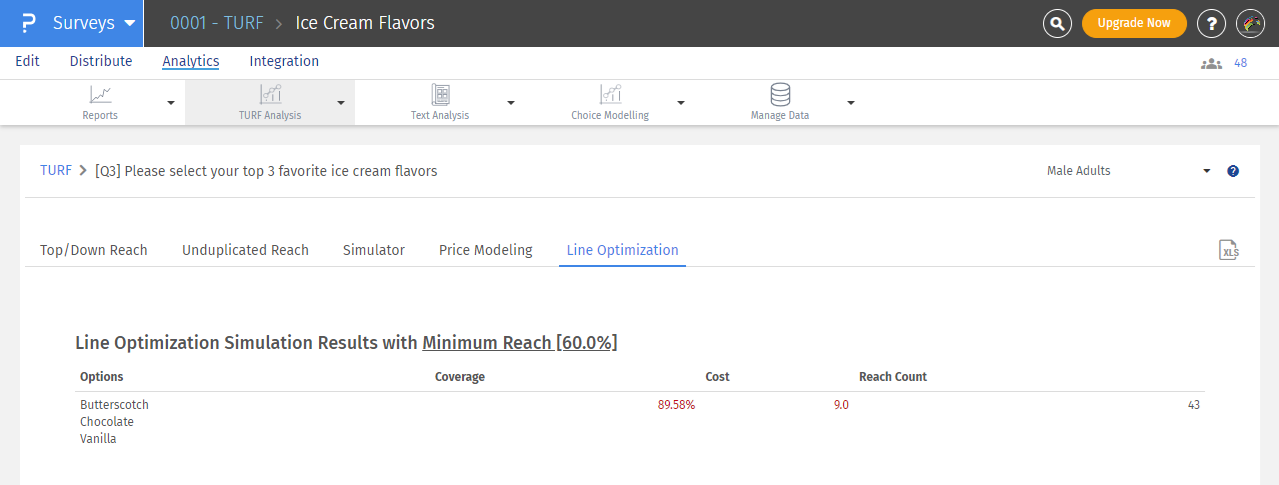
Yes. TURF analysis can be run with data filters. Select the filters to apply from the top right corner.
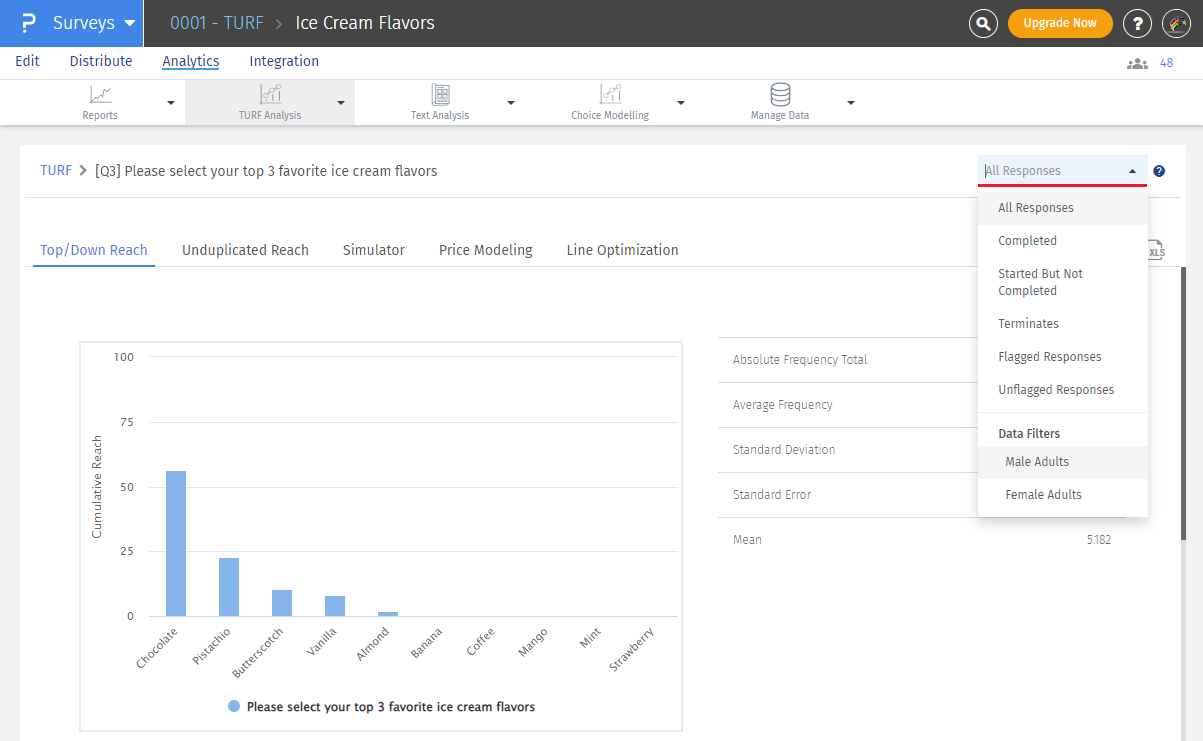
This feature is available with the following licenses :

